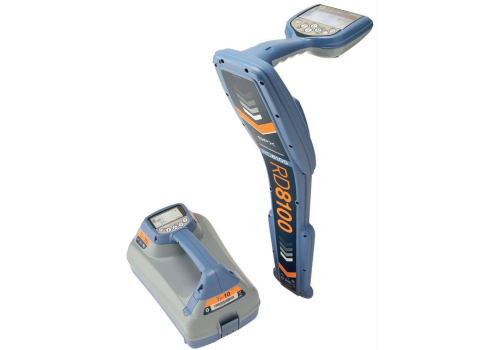Sometimes the best way to locate a utility is to ask someone who knows. By calling 811, you can get an idea of what’s underground even before you go out there and locate the utilities yourself. By knowing what’s in the ground, you can better choose which locating equipment to use and where to concentrate your efforts. You can also cross-reference the information with your data to make better determinations about what is underground.
If you don’t call before you perform the locate, definitely call before you dig, so you don’t risk hitting an active utility.
Locate technicians use several tools for locating underground utilities depending on the composition of the utility and soil conditions. Ferrous materials, such as metal pipes, cables, and tracer wires, are located using electromagnetism. Non-ferrous materials, such as plastic, clay, or concrete pipes, are located with either ground penetrating radar (GPR) or by introducing a ferrous material into the utility.
Finding conductive materials
Some utilities have a “signal” already on them and you can find those without needing to hook up your transmitter directly to the target line. Those utilities include power cables, gas lines, telecommunication lines, and others. Although this can be a quicker method, actively locating is the preferred way of locating active utilities.
“When you’re using an electromagnetic locator actively, you’re trying to create a circuit,” says Tanner Peterson, Territory Sales Manager, C&S Solutions. “With our equipment, you can induce a signal into the earth, use an induction clamp, or directly hook up the transmitter with your red and black leads, to the target conductor and you ground it with the black lead. The transmitter will tell you if you’ve created a circuit or not.”
Dial in the frequency
Frequency plays a big part in locating conductive materials. There are low and high frequencies and to what part of that spectrum you set your machine will influence the data received by the locator.
“Imagine the electromagnetic field that surrounds the utility to be like a slinky,” says Peterson. “At low frequency, it’s like pulling on each end of the slinky, which will create a tighter field around the conductor and can give you the most distance. I like to think of the electromagnetic field around the utility as the size of a golf ball when using frequencies under 1kHz. By contrast, if you were to turn the frequency up—and some locators go up to 400 kHz—now the field around the utility is the size of a house, and the distance you could go dramatically decreases.”
“At higher frequencies, you can start picking up multiple signals in the field,” continues Peterson. “Any other conductive materials in the ground you can bleed or couple your signal onto, which you can avoid by using lower frequencies. However, low frequencies don’t work well on high-resistance materials, such as ductile iron or cast iron pipes, or when locating a utility that has a loss of continuity. It’s usually the best practice to start with lower frequencies and work our way up. Most people want a repeatable process, so they usually begin with a common frequency, such as 8 kHz or 33 kHz, and adjust as needed”.
Create your own electromagnetic field
Electromagnetic locators aren’t helpful when there’s no conductive material in the utility, so there are a few options for introducing a conductive material into the utility.
1. A traceable rodder is like a fire hose. Connect a pipe and cable locator transmitter to one end and feed it into the utility. This allows you to transmit a locatable signal along the entire length of the utility up to 10 feet in depth.
2. Sewer inspection cameras can be equipped with a sonde and then be remotely navigated into a pipe. Inside the pipe, you can use the sewer inspection camera to find the defect or obstruction and then leave the camera parked there until the locate technician finds it with their locator and then marks the spot.
3. Marker balls can be used instead of tracer wire. Throw the ball into the hole next to the utility and bury it. Then you can use a locator capable of picking up marker balls.
 Going underground with ground-penetrating radar
Going underground with ground-penetrating radar
Ground penetrating radar (GPR) works by sending electromagnetic radar pulses into the earth which reflect back to the machine’s receiving antenna. The machine measures changes and produces signal reflections based on the conduction and dielectric properties of the objects below. The machine is not only capable of locating utilities but also inconsistencies in the ground material’s composition, such as voids or loose soil. Locate technicians then analyze the distortions in the signal reflection to determine what’s in the underlying material.
“If you get into GPR, you really have to look at the soil type,” says Peterson. “A lot of dense clay makes it more difficult to perform the locate. On backfilled areas and sandier spots, you can penetrate down 20 feet and that will pick up anything.”
Capture more data and save time
Bluetooth-enabled locators are relatively new to the market; they allow locate technicians to change frequency the of the receiver from up to half a mile away, which saves time and is convenient.
Also, manufacturers have introduced current direction in the last few years. They let you know the flow of the current of the utility to which you’re hooked up. If you’re bleeding onto another utility, that’s the return path, and the locate technician can know for sure which utility is which by the arrows on the locator. This eliminates guesswork when dealing with two utilities near each other.
“Geographical information systems (GIS) are becoming the way now,” says Peterson. “Locate technicians can locate and map at the same time with the push of a button on the receiver, and then integrate that data into a GIS.”
The GIS manages, maps, creates, and analyzes data. It marries geographic data with descriptive data to help users understand patterns, relationships, and geographic context. With this information, people can make better decisions regarding subsurface land use and underground utility maintenance and installation.
Subscribe to The Utility Expo monthly newsletter to receive more industry insights like this.
Read Next
Tips To Recruit And Retain Underground Utility Workers











